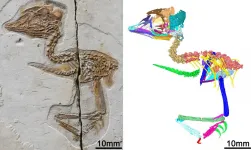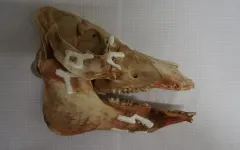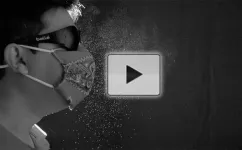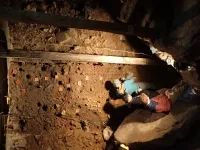Viruses as communication molecules
2021-06-23
(Press-News.org) How long do virus-laden particles persist in an elevator after a person infected with COVID-19 leaves? And is there a way to detect those particles? A group of electrical engineers and computer scientists at KAUST set out to answer these questions using mathematical fluid dynamics equations.
"We found1 that virus-laden particles can still be detected several minutes after a short elevator trip by an infected person," says KAUST electrical engineer Osama Amin.
The team's equations and breath simulations suggest that a biosensor's ability to detect a virus improves when placed on an elevator wall that can reflect particles. Also, to protect future occupants, the amount of particles in the air can be reduced by making the other three walls absorptive.
Amin and his colleagues at KAUST have been working on developing a nontraditional communication concept called "communication via breath." The concept2 models chemical and biological molecules emitted in exhaled breath as if they are information carriers in a communication system that can be detected on the other end by a "receiver," in this case a biosensor.
"This kind of study requires input from researchers with varied expertise in theoretical channel modeling, system design and integration, and machine learning schemes," says Amin.
In their previous work, they used equations to understand how exhaled molecules disperse in open spaces3. They also proposed4 a sensing system that can detect molecules exhaled from people's breath at mass gatherings.
In their current work, they developed a model and simulations that describe what happens to molecules exhaled in breath within a closed room over space and time. Their modeling took into consideration the abilities of walls to absorb or reflect particles. Once their models were able to describe, solve and simulate virus-laden particle concentration in a small room over space and time, the researchers worked on calculating the probability of a biosensor being able to detect those particles.
The calculations assumed the deployment of a biosensor that uses antibodies to bind to a specific virus and initiate a signal. They also accounted for parameters such as aerosol sampling time and volume, sampling efficiency and the probability of the antibodies binding to a virus.
"Our study provides vital mathematical and simulation gears for our leading research on communication via breath, which we hope will be used for more analyses and system designs," says KAUST computer scientist Basem Shihada.
The team is now developing an aerosol sampling and detection prototype for organic chemicals exhaled in breath. "We also plan on proposing mechanisms that reduce the probability of infection in small spaces, including ventilation mechanisms, periodical air sanitization and the design of absorptive and reflective walls," says Shihada.
INFORMATION:
[Attachments] See images for this press release:

ELSE PRESS RELEASES FROM THIS DATE:
2021-06-23
COLUMBIA, Mo. - Throughout her 20-year career as a nurse practitioner, Jennifer Hulett noticed survivors of breast cancer would often express gratitude for being alive and mention God or a divine acknowledgement that had improved their health and well-being.
Now an assistant professor at the University of Missouri Sinclair School of Nursing, Hulett is researching the benefits of spirituality on improving immune health and reducing stress, as well as the chances of cancer reoccurrence, among breast cancer survivors.
In a recent study, Hulett collected and froze samples of saliva from 41 breast cancer survivors at MU's Ellis Fischel Cancer Center. ...
2021-06-23
Researchers from the Institute of Vertebrate Paleontology and Paleoanthropology (IVPP) of the Chinese Academy of Sciences have discovered a 120-million-year-old partial fossil skeleton of a tiny extinct bird that fits in the palm of the hand and preserves a unique skull with a mix of dinosaurian and bird features.
The two-centimeter-long (0.75 inch) skull of the fossil shares many structural and functional features with the gigantic Tyrannosaurus rex, indicating that early birds kept many features of their dinosaurian ancestors and their skulls functioned much like those of dinosaurs rather than living ...
2021-06-23
MINNEAPOLIS/ST. PAUL (06/23/2021) -- A new report from the University of Minnesota Medical School's Healthy Youth Development - Prevention Research Center (HYD-PRC) highlights that Minnesota youth continue to contract sexually transmitted infections (STIs) at alarmingly high rates, despite the COVID-19 pandemic.
The 2021 Minnesota Adolescent Sexual Health Report says that chlamydia and gonorrhea rates among Minnesota adolescents in 2020 are likely underreported, as both STI testing and case detection were scaled back during the early stages of the pandemic. However, teen pregnancy rates remain virtually unchanged from 2018, and birth rates are at historic lows for ...
2021-06-23
The stink of ammonia in urine, sweat, and rotting meat repels humans, but many insects find ammonia alluring. Now, UConn researchers have figured out how the annoying insects smell it, a discovery that could lead to better ways to make them buzz off.
The sense of smell is enormously important. Mammals devote a third of their genetic code to odor receptors found in the nose, and have more than 1,000 different kinds that allow us to smell an estimated trillion different odors.
Flies don't have noses. Instead, they smell with their antenna. Each antenna is covered with tiny hairs called sensilla. Each sensilla contains a few neurons--fly brain cells. Each neuron expresses one type of odor receptor, and they all fall into two main ...
2021-06-23
A new biocompatible polymer-based composite material could soon replace metal plates in treating difficult and unstable fractures. Developed at KTH Royal Institute of Technology in Stockholm, the newly-developed material is as strong as dental composites yet non-toxic.
The material and a surgical method, which were published in Advanced Functional Materials, will be used in clinical studies in 2023 and 2024, with a focus on hand fractures.
Michael Malkoch, professor of fibre and polymer technology at KTH, says that the material and method, AdhFix, will enable customized plating for fixation of fractures with a more comfortable, less complicated recovery. Collarbone and rib fractures in particular are ideally suited for the proposed treatment, ...
2021-06-23
During the COVID-19 pandemic, cloth face masks became a way to help protect yourself and others from the virus. And for some people, they became a fashion statement, with many fabric choices available. But just how effective are they, especially in containing a sneeze? Now, researchers reporting in ACS Biomaterials Science & Engineering used high-speed videos of a person sneezing to identify the optimal cloth mask design. Watch a video of the sneeze cam here.
Early in the pandemic, worldwide shortages of surgical masks and N95 respirators led many people to make or purchase cloth face masks. Now, with safe and effective COVID-19 vaccines available, mask restrictions are ...
2021-06-23
A new study published in the Journal of the Association for Consumer Research posits that increased accessibility to anthropomorphized luck (i.e., "lady luck") can lead consumers to be more likely to pursue higher-risk financial behavior. In "Lady Luck: Anthropomorphized Luck Creates Perceptions of Risk-Sharing and Drives Pursuit of Risky Alternatives," authors Katina Kulow, Thomas Kramer, and Kara Bentley propose that preferences for higher-risk options (like lottery tickets with worse odds or investment opportunities with a low chance of return) are driven by shared risk perceptions that might engender feelings of security provided by the idea of "lady luck." This behavior, the authors note, "bodes ill for consumer welfare, given that many financial maladaptive activities ...
2021-06-23
Beyond how much cream and sugar to add to their morning brew, coffee lovers also face more serious decisions: one of those is whether or not to buy ecolabelled coffee, which advertises itself as more ethical and environmentally friendly. But whether customers are willing to pay the extra price for these perks remains an unanswered question. In a study publishing in the journal Heliyon on June 23, researchers combined data from 22 studies to conclude that in general, people are willing to pay $1.36 more for a pound of coffee that's produced in an eco-friendly way and are especially partial to coffee that's labelled "Organic."
"We hear in the media or sometimes read in the newspaper that there ...
2021-06-23
Researchers have developed a simple lab-based technique that allows them to look inside lithium-ion batteries and follow lithium ions moving in real time as the batteries charge and discharge, something which has not been possible until now.
Using the low-cost technique, the researchers identified the speed-limiting processes which, if addressed, could enable the batteries in most smartphones and laptops to charge in as little as five minutes.
The researchers, from the University of Cambridge, say their technique will not only help improve existing battery materials, ...
2021-06-23
Denisova Cave is located in the Altai Mountains in southern Siberia and is famous for the discovery of Denisovans, an extinct form of archaic humans that is thought to have occupied large parts of central and eastern Asia. Neandertal remains have also been found at the site, as well as a bone from a child who had a Neandertal mother and Denisovan father, showing that both groups met in the region. However, only eight bone fragments and teeth of Neandertals and Denisovans have been recovered so far from the deposits in Denisova Cave, which cover ...
LAST 30 PRESS RELEASES:
[Press-News.org] Viruses as communication molecules





